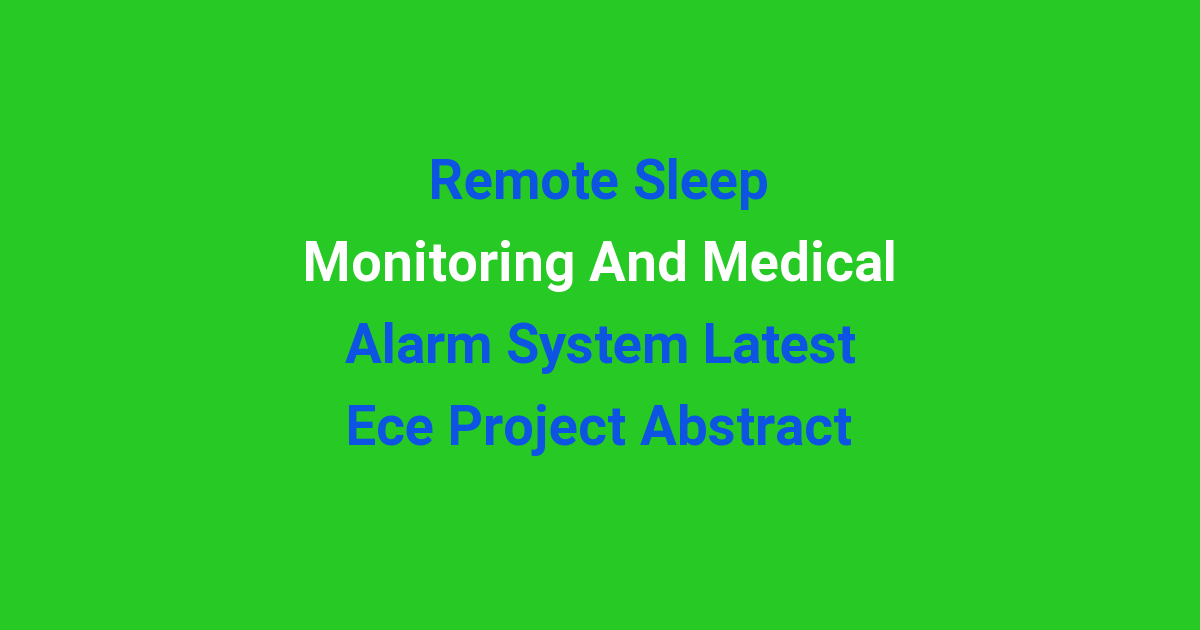The abstract of the latest ECE project involves a remote sleep monitoring and medical alarm system.
Remote Sleep Monitoring and Medical Alarm System Latest ECE Project Abstract
Introduction
In today’s fast-paced world, it is essential to prioritize our health and well-being. One crucial aspect of health is quality sleep, as it helps our bodies recharge and rejuvenate. However, many individuals struggle with sleep disorders that can have a significant impact on their overall health. This is where remote sleep monitoring and medical alarm systems come into play. These systems use cutting-edge technology to monitor an individual’s sleep patterns and provide alerts in case of any abnormalities. In this project, we aim to develop a remote sleep monitoring and medical alarm system that can revolutionize the way we approach sleep disorders.
Problem Statement
Sleep disorders are prevalent in today’s society, with many individuals suffering from conditions such as insomnia, sleep apnea, and restless leg syndrome. These disorders can have a detrimental effect on a person’s health, leading to fatigue, decreased cognitive function, and increased risk of chronic diseases. The current methods of diagnosing and monitoring sleep disorders are often expensive, time-consuming, and require the individual to visit a sleep clinic. This can be inconvenient and impractical for many people. Therefore, there is a need for a more accessible and convenient solution for monitoring sleep disorders.
Existing System
The existing system for monitoring sleep disorders typically involves the use of polysomnography (PSG), where the individual is required to spend a night in a sleep clinic hooked up to various sensors that monitor their brain activity, heart rate, and breathing patterns. While PSG is considered the gold standard for diagnosing sleep disorders, it is not ideal for long-term monitoring due to its high cost and inconvenience. Additionally, many individuals find it difficult to sleep in a new environment, which can affect the accuracy of the results.
Disadvantages
Some drawbacks of the existing system include:
– High cost of polysomnography
– Inconvenience of visiting a sleep clinic
– Difficulty sleeping in a new environment
– Lack of long-term monitoring capabilities
Proposed System
The proposed remote sleep monitoring and medical alarm system aims to address the limitations of the existing system by utilizing wearable technology and wireless communication. The system will consist of a wearable device that monitors the individual’s sleep patterns, including their heart rate, breathing rate, and movements. This data will be transmitted wirelessly to a centralized monitoring station, where healthcare professionals can analyze the information in real-time. In case of any abnormalities, such as irregular breathing or sudden changes in heart rate, the system will trigger an alarm to alert the individual or their caregiver.
Advantages
Some advantages of the proposed system include:
– Cost-effective compared to polysomnography
– Convenience of monitoring sleep at home
– Continuous monitoring for long-term analysis
– Early detection of sleep disorders
– Immediate alerts in case of abnormalities
Features
The remote sleep monitoring and medical alarm system will have the following features:
– Wearable device for comfortable and non-intrusive monitoring
– Wireless communication for seamless data transmission
– Real-time monitoring by healthcare professionals
– Customizable alarm settings for personalized alerts
– Data storage for long-term analysis and trend tracking
Conclusion
In conclusion, the development of a remote sleep monitoring and medical alarm system has the potential to revolutionize the way we diagnose and monitor sleep disorders. By utilizing wearable technology and wireless communication, we can provide a cost-effective and convenient solution for individuals struggling with sleep disorders. The proposed system offers continuous monitoring, early detection of abnormalities, and immediate alerts, making it an invaluable tool for improving sleep quality and overall health. With further research and development, this system can make a significant impact on the field of sleep medicine and contribute to a healthier society.

